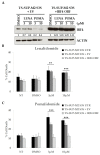IRF4 Mediates the Oncogenic Effects of STAT3 in Anaplastic Large Cell Lymphomas
- PMID: 29346274
- PMCID: PMC5789371
- DOI: 10.3390/cancers10010021
IRF4 Mediates the Oncogenic Effects of STAT3 in Anaplastic Large Cell Lymphomas
Abstract
Systemic anaplastic large cell lymphomas (ALCL) are a category of T-cell non-Hodgkin's lymphomas which can be divided into anaplastic lymphoma kinase (ALK) positive and ALK negative subgroups, based on ALK gene rearrangements. Among several pathways aberrantly activated in ALCL, the constitutive activation of signal transducer and activator of transcription 3 (STAT3) is shared by all ALK positive ALCL and has been detected in a subgroup of ALK negative ALCL. To discover essential mediators of STAT3 oncogenic activity that may represent feasible targets for ALCL therapies, we combined gene expression profiling analysis and RNA interference functional approaches. A shRNA screening of STAT3-modulated genes identified interferon regulatory factor 4 (IRF4) as a key driver of ALCL cell survival. Accordingly, ectopic IRF4 expression partially rescued STAT3 knock-down effects. Treatment with immunomodulatory drugs (IMiDs) induced IRF4 down regulation and resulted in cell death, a phenotype rescued by IRF4 overexpression. However, the majority of ALCL cell lines were poorly responsive to IMiDs treatment. Combination with JQ1, a bromodomain and extra-terminal (BET) family antagonist known to inhibit MYC and IRF4, increased sensitivity to IMiDs. Overall, these results show that IRF4 is involved in STAT3-oncogenic signaling and its inhibition provides alternative avenues for the design of novel/combination therapies of ALCL.
Keywords: ALK; IRF4; JQ1; STAT3; anaplastic large cell lymphomas; immunomodulatory drugs.
Conflict of interest statement
The authors have no conflicts of interest.
Figures






References
-
- Stein H., Mason D.Y., Gerdes J., O’Connor N., Wainscoat J., Pallesen G., Gatter K., Falini B., Delsol G., Lemke H., et al. The expression of the hodgkin’s disease associated antigen Ki-1 in reactive and neoplastic lymphoid tissue: Evidence that reed-sternberg cells and histiocytic malignancies are derived from activated lymphoid cells. Blood. 1985;66:848–858. - PubMed
-
- Swerdlow S.H., Campo E., Pileri S.A., Harris N.L., Stein H., Siebert R., Advani R., Ghielmini M., Salles G.A., Zelenetz A.D., et al. The 2016 revision of the world health organization classification of lymphoid neoplasms. Blood. 2016;127:2375–2390. doi: 10.1182/blood-2016-01-643569. - DOI - PMC - PubMed
-
- Morris S.W., Naeve C., Mathew P., James P.L., Kirstein M.N., Cui X., Witte D.P. ALK, the chromosome 2 gene locus altered by the t(2;5) in non-Hodgkin’s lymphoma, encodes a novel neural receptor tyrosine kinase that is highly related to leukocyte tyrosine kinase (LTK) Oncogene. 1997;14:2175–2188. doi: 10.1038/sj.onc.1201062. - DOI - PubMed
LinkOut - more resources
Full Text Sources
Other Literature Sources
Miscellaneous

